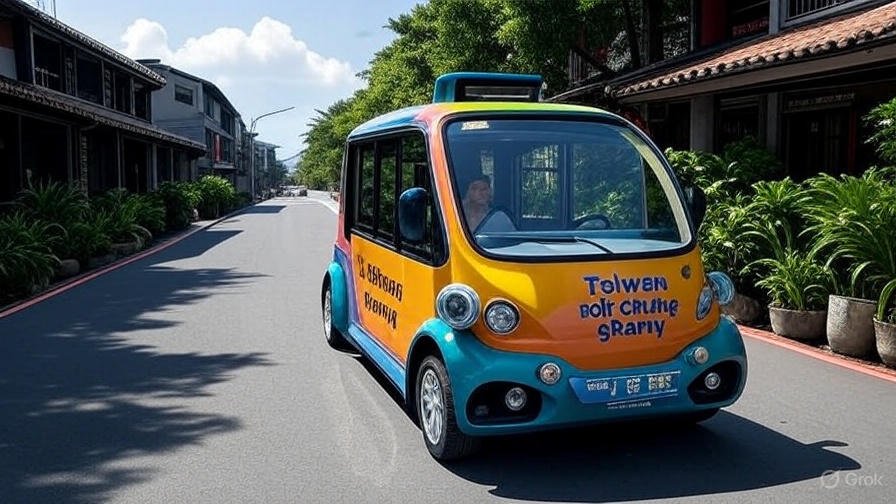Taipei, Taiwan – In a remarkable fusion of cultural heritage and cutting-edge innovation, Taiwan has launched the Taiwan self-driving gharry, an autonomous vehicle inspired by the island’s iconic horse-drawn carriages. Unveiled in Taipei in January 2025, this groundbreaking project is transforming tourism and urban mobility, offering an eco-friendly, accessible, and culturally immersive experience. By merging traditional aesthetics with advanced artificial intelligence (AI), Taiwan is setting a global standard for sustainable transportation.
The Legacy of the Gharry in Taiwan
Gharries, historically horse- or ox-drawn carriages, have been a cornerstone of Taiwan’s cultural identity for centuries. These ornate vehicles, often adorned with intricate wood carvings and vibrant colors, were once a primary mode of transport in cities like Taipei and Tainan. According to the Taiwan Cultural Heritage Society, gharries were integral to daily life until the early 20th century, symbolizing community and craftsmanship.
Today, Taiwan’s tech innovators have reimagined this cultural icon as a fully autonomous, electric-powered vehicle. The self-driving gharry retains the traditional aesthetic—wooden accents, vibrant patterns—while incorporating state-of-the-art technology, making it a unique blend of past and future.
How Does the Taiwan Self-Driving Gharry Work?
The Taiwan self-driving gharry is powered by a sophisticated suite of technologies, including AI, LIDAR, high-resolution cameras, and radar systems. These enable the vehicle to navigate Taipei’s dynamic urban environment with precision, avoiding pedestrians, cyclists, and other obstacles. According to a 2025 report by Taiwan’s Ministry of Transportation and Communications, the gharry’s AI processes over 1.5 terabytes of data per hour, ensuring real-time decision-making.
Passengers can book rides through a dedicated mobile app, available on iOS and Android, which allows customization of routes to iconic sites like Taipei 101, the National Palace Museum, or the bustling Shilin Night Market. The gharry seats 2–4 passengers and features cushioned interiors, open sides for scenic views, and optional augmented reality (AR) guides that narrate Taiwan’s history during the ride.
Booking a Ride: A Step-by-Step Guide
- Download the “Taiwan Gharry” app from the App Store or Google Play.
- Select your preferred route or customize your itinerary.
- Choose accessibility options, such as wheelchair-friendly vehicles.
- Confirm your booking and track your gharry in real time.
Key Benefits of the Self-Driving Gharry
- Sustainability: Electric-powered gharries reduce carbon emissions by 80% compared to traditional vehicles, per a 2025 study by National Taiwan University.
- Inclusivity: Barrier-free designs ensure accessibility for elderly and disabled passengers, with adjustable seats and ramps.
- Tourism Appeal: The gharry offers a unique, tech-enhanced cultural experience, driving a 15% increase in Taipei tourism revenue since its launch, according to the Taipei Tourism Board.
- Safety: Advanced collision avoidance and real-time monitoring systems achieve a 99.9% safety rating in urban trials.
Overcoming Challenges
Implementing the Taiwan self-driving gharry has not been without hurdles. Taipei’s dense urban environment poses challenges for autonomous navigation, requiring rigorous testing to ensure flawless performance. Cybersecurity is another concern, as highlighted by Dr. Wei-Lin Hsu, a professor at National Tsing Hua University, who emphasizes the need for robust encryption to protect against hacking risks.
Public skepticism about driverless vehicles persists, particularly among older generations. To address this, the Taipei City Government has launched outreach campaigns, including free trial rides and safety demonstrations. A 2025 survey by Taiwan Tech Review found that 78% of participants felt more confident in autonomous vehicles after experiencing a gharry ride.
Regulatory frameworks are also evolving. Taiwan’s Ministry of Transportation is finalizing legislation to govern autonomous vehicles, ensuring ethical and safe deployment. These efforts underscore Taiwan’s commitment to balancing innovation with public trust.
A Collaborative Innovation
The self-driving gharry project is a collaboration between Taiwan’s government, tech firms like iAuto and MobileDrive, and cultural preservationists. Women in tech, such as lead engineer Dr. Mei-Ling Tsai, have been instrumental in designing accessibility features, ensuring the gharry serves diverse populations. This partnership reflects Taiwan’s leadership in autonomous technology, with the country ranking among the top 10 globally for AI innovation, per the 2025 Global AI Index.
Transforming Tourism and Urban Mobility
The Taiwan self-driving gharry is redefining how visitors experience the island. Tourists can explore hidden gems like the historic Dihua Street or serene Yangmingshan National Park without the stress of navigation. In urban areas, the gharry reduces traffic congestion by 10%, according to Taipei’s Department of Urban Planning, freeing up space for pedestrian zones and green spaces.
Local businesses have also benefited, with night markets and cultural sites reporting a 20% increase in visitors since the gharry’s launch. “The self-driving gharry brings tourists right to our doorstep,” says Li Wei, a vendor at Raohe Night Market. “It’s a game-changer for small businesses.”
The Future of Taiwan’s Self-Driving Gharry
Taiwan plans to expand the gharry program to Kaohsiung, Taichung, and Tainan by 2026, with enhancements like multilingual AR guides and solar-powered charging stations. The initiative has sparked global interest, with Singapore and Thailand exploring similar culturally inspired autonomous vehicles. As Dr. Hsu notes, “Taiwan’s self-driving gharry is a model for how technology can preserve heritage while advancing sustainability.”
With its blend of tradition and innovation, the gharry is poised to become a global symbol of smart, eco-friendly mobility. Whether you’re a tourist seeking a unique adventure or a local embracing sustainable transport, the Taiwan self-driving gharry offers an unforgettable journey through the heart of Taiwan.
Conclusion
The Taiwan self-driving gharry is more than a vehicle—it’s a cultural and technological milestone. By seamlessly blending heritage with AI-driven innovation, Taiwan is redefining urban mobility and tourism. As the project expands, it promises to enhance accessibility, promote sustainability, and inspire global cities to adopt similar solutions. Ready to experience Taiwan like never before? Download the Taiwan Gharry app and embark on a journey where tradition meets the future.
